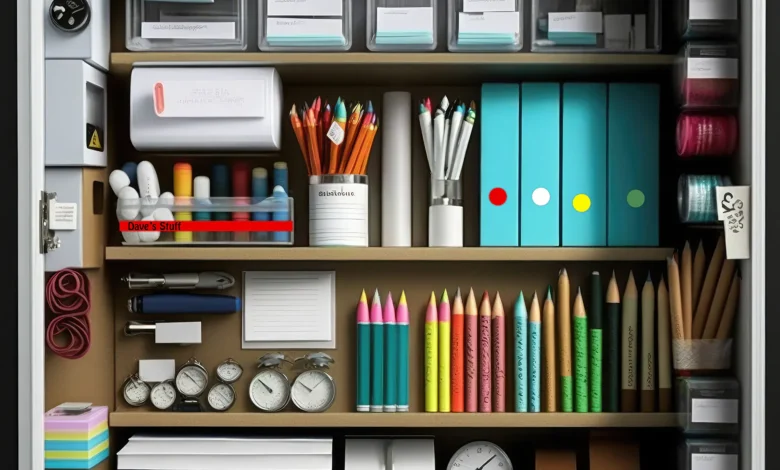Inside the Supply Cupboard: Why Organisation Matters More Than You Think

At nine o’clock on a Monday morning, the classroom hums with the kind of energy that only children can bring. In one corner, a group searches for scissors among piles of paper. Across the room, a teacher rummages for glue sticks that have vanished again. The clock ticks. The lesson slides off track. Now picture another classroom. The scissors sit neatly in a labelled box, glue sticks in a clear container by the craft table, paper stacked by size and colour. The teacher begins the lesson with a calm smile. The pupils settle faster, and the morning unfolds smoothly. The difference between the two rooms is not luck or extra funding. It is organisation.
Behind every calm classroom is a quiet system that keeps chaos at bay. Shelves, trays, trolleys, and labels might seem dull compared to lesson plans or technology, but they form the hidden scaffolding of a good learning environment. Organisation saves minutes, which soon turn into hours. It gives pupils a sense of order and helps teachers think clearly. When every item has a home, from the whiteboard pens to the glue sticks, the classroom becomes more than tidy—it becomes a space that supports focus and creativity.
The Subtle Power of a System
A well-organised classroom does more than look neat. It gives structure to the day. Children thrive in environments where expectations are clear, and that includes where they find their materials. When pupils know exactly where to return the glue sticks after art or where the rulers belong after maths, they learn responsibility as naturally as they learn spelling.
Teachers benefit too. A thoughtful layout saves the small but constant frustrations that can chip away at patience. A shelf dedicated to art supplies prevents wasted time before creative lessons. Storage boxes with transparent lids make it easy to see what needs replenishing. Even a small adjustment, such as grouping supplies by activity rather than type, can streamline preparation. For instance, a tray labelled “display work” might include glue sticks, sticky tack, and trimmers together, ready for one task instead of scattered across the room.
Designing Classrooms that Work
The best organisation systems grow from observation. Teachers quickly learn which areas attract clutter. The craft corner might need open baskets rather than deep drawers so pupils can see what’s inside. The reading area might benefit from simple labels with both words and pictures so younger children can tidy up independently.
Suppliers play a key role in supporting this order. Storage products designed for schools must be sturdy, stackable, and intuitive. Colour-coded trays and modular shelving let teachers adapt their space as their class grows. Even small details, like rounded edges or handles built for small hands, can make daily routines smoother.
Some companies are now rethinking packaging and product design to reduce clutter before it even begins. Glue sticks that fit neatly into organisers, refillable containers that cut down on bulk packaging, and multi-purpose storage boxes all make a difference. When suppliers consider how their products live in a classroom rather than just how they look in a catalogue, teachers notice.
Marketing Order as Calm
There is an opportunity for suppliers to go beyond selling products and instead promote peace of mind. A tidy classroom means fewer interruptions, cleaner transitions between activities, and happier teachers. Marketing that focuses on time saved rather than space filled speaks directly to the heart of what teachers value. A classroom shelf is not just furniture—it is a time-saving tool.
Products can be marketed through real classroom stories. A teacher who spends less time searching for glue sticks or exercise books can focus more on creative projects. A headteacher who invests in a cohesive storage system might see better resource sharing across year groups. The message becomes not about tidiness for its own sake, but about how organisation supports education itself.
The Psychology of a Tidy Space
There is a deep connection between environment and learning. Clutter creates distraction, and distraction reduces concentration. A clean, well-organised classroom helps children settle quickly and reduces anxiety. Even colour schemes and layout matter. Soft, natural tones with clear storage systems promote calmness and focus.
Teachers feel the benefit too. A cluttered desk can make even the most experienced teacher feel behind. Knowing exactly where the spare glue sticks or spare worksheets are stored restores confidence and control. When the classroom feels under control, the people inside it can focus on the joy of learning rather than the stress of searching.
Organisation also helps to prevent waste. Supplies that are easy to find are less likely to be lost or duplicated. A visible, labelled box for used glue sticks encourages recycling or refilling. A small cupboard inventory at the end of each week can prevent unnecessary reorders. These are quiet efficiencies that add up over time, saving both money and effort.
Practical Steps for Everyday Calm
Teachers can start small. A clear-out at the end of each term resets the space. Creating zones—art, reading, writing, science—helps pupils associate activities with specific areas. Using see-through boxes and simple labels supports independence. Rotating seasonal displays keeps walls fresh and avoids visual overload.
For many teachers, the humble glue stick becomes a symbol of order. It is small, essential, and constantly used. When it is missing, lessons stall. When it is where it should be, everything flows. That same principle applies to every corner of the classroom. The goal is not perfection but flow—the smooth rhythm that lets learning happen naturally.
Calm, Creative, and Ready to Learn
The tidiest classrooms are not cold or clinical. They are spaces alive with creativity and colour, where children can experiment freely because boundaries exist to hold that freedom safely. Organisation is not about control—it is about clarity.
Inside the supply cupboard lies the secret of classroom harmony. Every glue stick, pen, and paperclip in its place represents time given back to teaching. Order gives teachers room to breathe and pupils space to think. The best classrooms are those where everything works quietly in the background, allowing imagination and focus to take centre stage.
A calm classroom is not built overnight. It grows from thoughtful choices, practical systems, and a shared respect for the materials that make learning possible. When order reigns behind the cupboard door, the entire room feels lighter, brighter, and ready for whatever lesson comes next.



